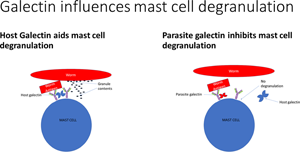Crossref Citations
This article has been cited by the following publications. This list is generated based on data provided by
Crossref.
E. Olguín, Jonadab
and
Ignacio Terrazas, Luis
2021.
Current State of the Art in Cysticercosis and Neurocysticercosis.
Hafidi, Nur Nasuha
Swan, Jaclyn
Faou, Pierre
Lowe, Rohan
Rajapaksha, Harinda
Cairns, Callum
Stear, Michael
and
Beddoe, Travis
2021.
Teladorsagia Circumcincta Galectin-Mucosal Interactome in Sheep.
Veterinary Sciences,
Vol. 8,
Issue. 10,
p.
216.
Donskow-Łysoniewska, Katarzyna
Maruszewska-Cheruiyot, Marta
Krawczak-Wójcik, Katarzyna
Gonzalez, Jorge F.
Hernández, Julia N.
and
Stear, Michael J.
2022.
Nematode galectin binds IgE and modulates mast cell activity.
Veterinary Parasitology,
Vol. 311,
Issue. ,
p.
109807.
Hao, Hui Nan
Song, Yan Yan
Ma, Kai Ning
Wang, Bo Ning
Long, Shao Rong
Liu, Ruo Dan
Zhang, Xi
Wang, Zhong Quan
and
Cui, Jing
2022.
A novel C-type lectin from Trichinella spiralis mediates larval invasion of host intestinal epithelial cells.
Veterinary Research,
Vol. 53,
Issue. 1,
Maruszewska-Cheruiyot, Marta
Stear, Michael James
Machcińska, Maja
and
Donskow-Łysoniewska, Katarzyna
2022.
Importance of TGFβ in Cancer and Nematode Infection and Their Interaction—Opinion.
Biomolecules,
Vol. 12,
Issue. 11,
p.
1572.
Stear, Michael
Preston, Sarah
Piedrafita, David
and
Donskow-Łysoniewska, Katarzyna
2023.
The Immune Response to Nematode Infection.
International Journal of Molecular Sciences,
Vol. 24,
Issue. 3,
p.
2283.
Rashidi, Sajad
Mansouri, Reza
Ali-Hassanzadeh, Mohammad
Muro, Antonio
Nguewa, Paul
and
Manzano-Román, Raúl
2023.
The most prominent modulated Annexins during parasitic infections.
Acta Tropica,
Vol. 243,
Issue. ,
p.
106942.
Dishnica, Klevia
Piubelli, Chiara
Manfredi, Marcello
Kondaveeti, Ravi Teja
Longoni, Silvia Stefania
Degani, Monica
Buonfrate, Dora
Giorgetti, Alejandro
and
Tiberti, Natalia
2023.
Novel insights into the somatic proteome of Strongyloides stercoralis infective third-stage larvae.
Parasites & Vectors,
Vol. 16,
Issue. 1,
Pérez-Hernández, Tara
Hernández, Julia N.
Machín, Cynthia
McNeilly, Tom N.
Nisbet, Alasdair J.
Matthews, Jacqueline B.
Burgess, Stewart T.G.
and
González, Jorge F.
2023.
Exploring the transcriptomic changes underlying recombinant vaccine efficacy against Teladorsagia circumcincta in 3-month-old lambs.
Veterinary Parasitology,
Vol. 320,
Issue. ,
p.
109960.
Wang, Zhen
Lu, Qi Qi
Weng, Min Min
Li, Yang Li
Han, Lu Lu
Song, Yan Yan
Shi, Yu Long
Liu, Ruo Dan
Cui, Jing
and
Wang, Zhong Quan
2023.
Binding of Trichinella spiralis C-type lectin with syndecan-1 on intestinal epithelial cells mediates larval invasion of intestinal epithelium.
Veterinary Research,
Vol. 54,
Issue. 1,
Maruszewska-Cheruiyot, Marta
Szewczak, Ludmiła
Krawczak-Wójcik, Katarzyna
Stear, Michael James
and
Donskow-Łysoniewska, Katarzyna
2024.
Nematode Galectin Inhibits Basophilic Leukaemia RBL-2H3 Cells Apoptosis in IgE-Mediated Activation.
International Journal of Molecular Sciences,
Vol. 25,
Issue. 13,
p.
7419.
Tiberti, Natalia
Manfredi, Marcello
Piubelli, Chiara
and
Buonfrate, Dora
2024.
Progresses and challenges in
Strongyloides
spp. proteomics
.
Philosophical Transactions of the Royal Society B: Biological Sciences,
Vol. 379,
Issue. 1894,
Vu, Van Sang
Niciura, Simone Cristina Meo
and
Gondro, Cedric
2024.
Immune response against gastrointestinal nematodes and the potential application of immortalized cell lines in the sheep industry.
Vietnam Journal of Science and Technology,
Rivory, Phoebe
Lee, Rogan
and
Šlapeta, Jan
2025.
Isolate-specific rat brain transcriptional responses to rat lungworm (Angiostrongylus cantonensis).
Pathogens and Disease,
Vol. 83,
Issue. ,




